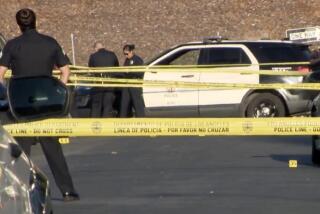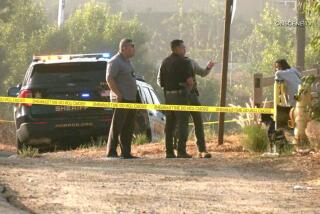After four years, investigators determine motive behind Aguanga mass killings

- Share via
Four years ago, six people were shot and killed at a large-scale marijuana operation in the small community of Aguanga in Riverside County, with a seventh victim dying in a local hospital later. Police called it one of the county’s worst mass killings.
At the time, Riverside County sheriff‘s investigators had little information about the shooting, let alone any information about the identity of the potential shooters. It would also take weeks before coroners would release the identity of the victims.

But investigators said in a statement released Wednesday that the killings appeared to have been a home invasion robbery by San Diego-based gang members of Laotian descent who targeted a massive marijuana growing operation.
For the record:
8:39 p.m. Dec. 23, 2024An earlier version of this article incorrectly stated that investigators said in a written statement released Thursday that the killings appeared to have been a home invasion robbery by San Diego-based gang members of Laotian descent who targeted a massive marijuana growing operation. The statement was released Wednesday.
Investigators said they have also identified a vehicle — a midsize, dark colored SUV — that was used during the crime.
The newly released new details underscore the Sheriff’s Department’s determination to solve the brazen mass killing.
The Sept. 7, 2020, shooting occurred on a remote property nestled on the edge of the Cleveland National Forest. It included a house, a trailer and other makeshift dwellings. At least 20 people lived on the property, according to the Riverside County Sheriff’s Department.
Investigators said evidence at the scene indicated the property was being used to manufacture and harvest illicit marijuana. More than 1,000 pounds of marijuana and several hundred marijuana plants, valued between $1 million and $5 million, were located at the scene. The shooting appeared to coincide with peak harvest time.

The dead — five women and two men — were identified by the sheriff’s office as Samantha Sourignasak, 44, and Khamphour Nanthavongdovane, 53, both of Las Vegas; Phone Chankhamany, 54, of Murrieta; Thongpath Luangkoth, 47; and Souphanh Pienthiene, 48. Also killed were Anaheim residents Vikham Silimanotham, 64, and Khamtoune Silimanotham, 59.
In an interview with The Times, Phone Chankhamany’s son said the victims were mostly recent immigrants from Laos with little paper trail.
Chankhamany’s son, whom The Times is not naming for his safety, said his mother had overseen the grow. She was born in Laos and came to the United States about 16 years ago, he said in an interview at his uncle’s home.
Several of his mother’s friends worked at the site, he said, alongside a revolving cast of recent immigrants from Laos, who, unable to speak English and struggling to find employment, would work and live on the property until they made enough cash to move on.
“Usually, when they come to the U.S., it’s the first thing they do to make money,” he said.
The mass shooting underscored California’s pervasive black market that has continued despite the state legalizing recreational marijuana in 2016. The black market’s growth is driven in part by cannabis operators who seek to evade expensive licensing fees and other regulatory costs, allowing them to undercut competitors.
But the illegal operations, especially in more remote areas of the state, have led to violence that includes shootings and dismemberments.
So far this year, an estimated $353 million worth of illicit plants have been seized through a California Department of Justice program, while a task force with the governor’s office has seized an estimated $191 million.
Riverside sheriff’s detectives said the investigation into the Aguanga mass killing is ongoing. They’re asking anyone with information about the killings to call (951) 955-2777 or used the online tip line, which can be accessed on the sheriff’s website.
Times staff writers Matt Ormseth and Clara Harter contributed to this report.
More to Read
Sign up for Essential California
The most important California stories and recommendations in your inbox every morning.
You may occasionally receive promotional content from the Los Angeles Times.










